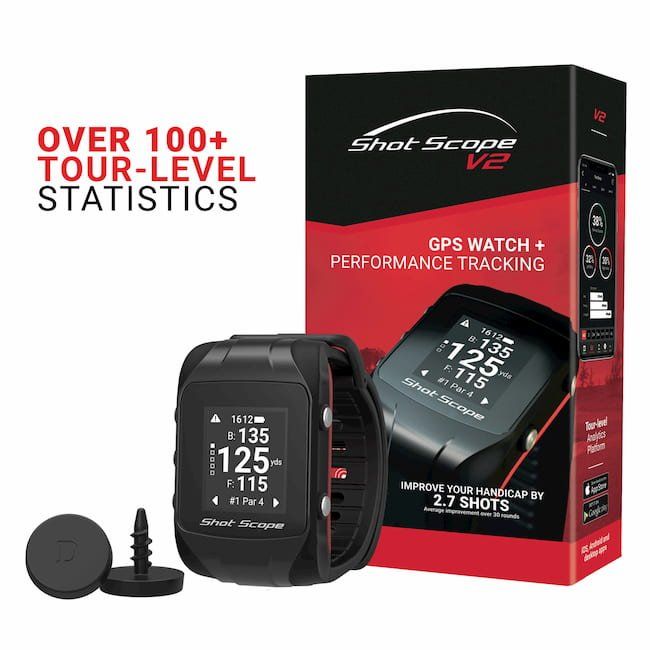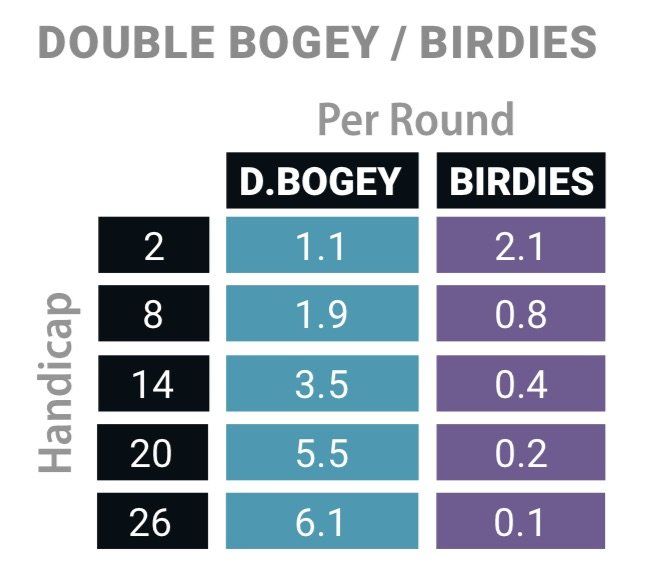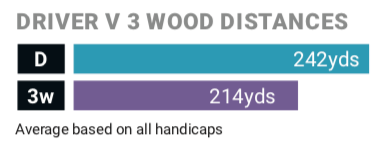
For years, anecdotal information dominated the discussion of golf improvement. It still does in many circles. With newer technology, we have more reliable data on which to base decisions, rather than guess. In my experience, taking a healthy dose (but not too much) of this information can help players improve.
One of the most interesting developments in recent years is the ability to track golfers' real performance on the course. Instead of listening to their accounts of the round, we now have cold-hard data that shows us exactly how far players are hitting shots, where they are losing strokes and many other interesting nuggets of information. With millions and millions of shots tracked, a lot of interesting trends have been observed. In this article, I was able to show how golfers' performance changed by handicap level based on Shot Scope's 20 million shot library.
Recently, Shot Scope released a new eBook that outlines some of the biggest strategic mistakes they see golfers making. Their database surpassed 30 million shots, and they uncovered quite a few common errors.

I will summarize four major mistakes that golfer's make. I think they'll surprise some of you, and change your thinking on commonly-held beliefs. If you are interested in downloading the entire eBook, you can do so here (it's an interesting read).
I Need to Make More BIRDIES!!!
Ever since I started Practical Golf in 2015, I have been beating my drum as loud as possible when it comes to the idea of birdies and double bogeys. The official tagline of the site has become, "fighting the war on double bogeys."
Most golfers think that they need to make more birdies to become a better player. I tell everyone who would listen that it's more about limiting double bogeys (or worse). I discussed the concept of birdies in this article, and how golfers have it all wrong.
Shot Scope looked at five different handicap levels, and compared the number of birdies they make per round as well as double bogeys:

As you can see, almost all handicap levels average well below one birdie per round. The main differentiator in performance between the two is clearly double bogeys. Going from a 26 down to an eight handicap shows a reduction of four double bogeys per round. Lower handicap players are better at avoiding double bogeys than making more birdies.
Birdies are a nice bonus when they happen, but your main focus should be doing everything you can to limit double bogeys. That is Practical Golf in a nutshell, folks!
3-Wood For Accuracy Off the Tee
Conventional logic assumes that a shorter club off the tee will be more accurate. For years, I thought this myself. I find myself thinking otherwise, especially after I performed this test with my iron and driver.
Many times, golfers will choose to hit a 3-wood off the tee when they feel they want more accuracy. However, there are two questions you need to think about when you do this:
- How much distance are you giving up?
- What are you gaining in accuracy?
To answer the first question - most golfers are giving up somewhere around 30 yards in distance when it comes to a driver vs. a 3-wood. Less distance off the tee will cost you strokes. In my other article featuring Shot Scope's findings, the difference in distance between driver and 3-wood was worth about 1/3 of a stroke.

Now, what did those golfers gain in accuracy? Well, it turns out, not much. Using a 3-wood off the tee only improved fairway accuracy by 1% point.

I've discussed before how fairway accuracy is not the best measurement for tee shot success. However, if 3-woods were much more accurate than driver off the tee, then surely you would see a huge jump in fairways hit.
There are multiple reasons why this is the case. For starters, it's much harder to make solid contact with a 3-wood than a driver because of the smaller face. Gear effect becomes a huge issue, which is essentially a punishment for off-center impact. Most modern drivers are far more forgiving because the clubfaces are larger, and have much more MOI (a measure of forgiveness).
Overall, this data is a bit of an eye-opener. Essentially golfers (as a whole) are losing strokes by laying back off the tee, and not gaining any increase in accuracy.
Laying Up To Your Favorite Yardage
Another piece of conventional strategic wisdom is to try and lay up to your favorite yardage, especially on a par 5.
Often, golfers will choose to leave themselves with a 100-yard shot instead of a 40-50 yard shot because they want to take a full swing. In theory, it makes perfect sense. However, this strategy was deemed ineffective in Mark Broadie's groundbreaking book Every Shot Counts. His statistical analysis found that given the choice between an 80-yard shot and a 30-yard shot, golfers of all levels would score better when they are closer to the hole. The only caveat is not to take on additional risk when trying to lay up closer to the hole.
So how did this analysis stack up in the real world?
Pretty well!

Across the board, golfers were able to land the ball closer to the hole by almost 30 feet when looking at approaches from 110 yards vs. 50 yards.
Lob Wedge Addiction
One of the areas where most golfers can quickly gain a few strokes are around the greens. I prefer that most players try to simplify their short game, and not try too many different techniques (ie. flop shots). However, you can simply change out the club you are using to alter your trajectory based on the situation.
For example, a lot of players get a little obsessed with using the most lofted club in their bag for most pitch and chip shots. One area in particular where this can cause problems is when the golfer has plenty of green to work with. Let's say you've left your approach shot short of the green, and have about 30 yards in between you and the flag. Using a more lofted club will require very precise distance control, which is a skill that needs to be worked on quite a bit. Often times, golfers will end up leaving these kinds of shots well short of the flag, and sometimes even fail to reach the green.
Shot Scope did an interesting analysis of the variety of clubs used by golfers around the green. They chose to separate players by those who can consistently land the ball inside 20 feet versus those who did not. What they found is that the players who had better proximity to the hole used more of their clubs around the green, rather than relying only on one or two.
When they examined the profile of poor short-game players, they found a mixture of club usage similar to the following image:

Conversely, better short-game players had a more even dispersion of club usage across the board:

Overall, club selection can be a personal choice. This is an area of the game where I think it makes sense to pay close attention to your results. Often times golfers will use similar clubs out of habit and ignore the fact that they might be giving up performance gains if they adjusted their club selection based on the circumstances.
How To Customize Your Data
Looking at golfers across the board is certainly an interesting study. A lot of the revelations from the Shot Scope data are problems I've found observing golfers of all levels (including my own game). But each and every one of you has a unique style of play and ability. I always recommend that golfers keep track of their stats and take a deeper dive beyond the traditional ones. With the advent of shot-tracking systems, it's easier than ever for golfers to track their shots on the course and get a detailed analysis of where they need to improve.
I've reviewed a number of these systems, and Shot Scope, in my opinion, is the easiest to use when you factor in all of the features. Currently, they are running a holiday special for $139 on their website here, which is more than $100 less than the system used to cost when I first reviewed it.
Once you can get a birds-eye view of your golf game, it's much easier to see where you can make adjustments with your practice, strategy, and even equipment.
We care about the protection of your data Read our Privacy Policy